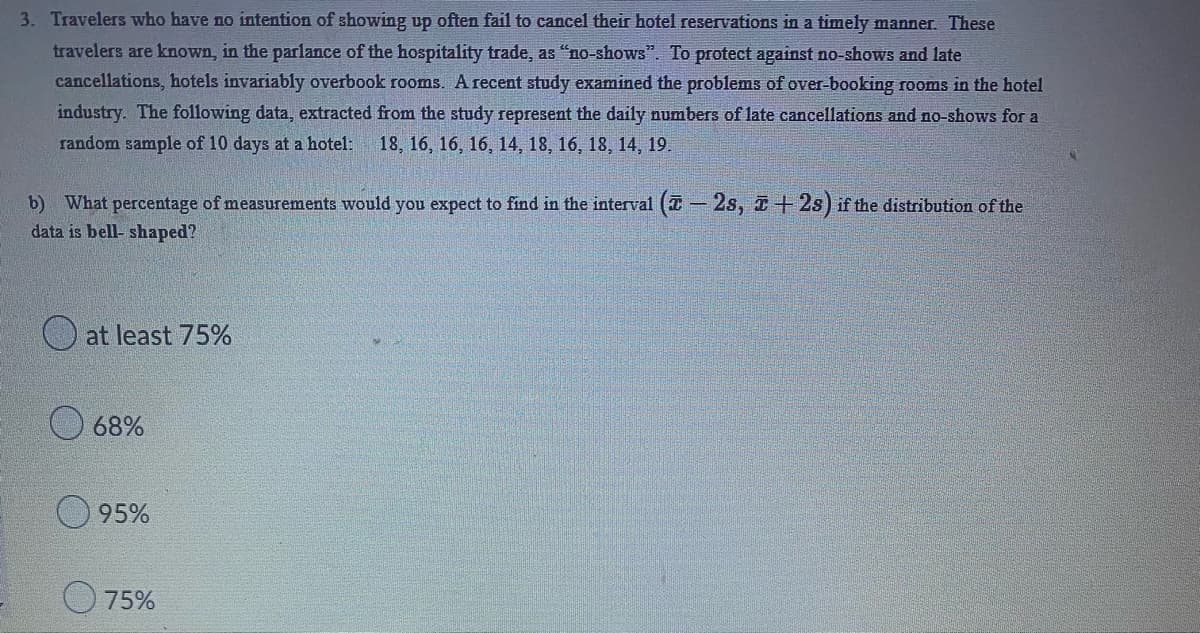3. Travelers who have no intention of showing up often fail to cancel their hotel reservations in a timely manner. These travelers are known, in the parlance of the hospitality trade, as "no-shows". To protect against no-shows and late cancellations, hotels invariably overbook rooms. A recent study examined the problems of over-booking rooms in the hotel industry. The following data, extracted from the study represent the daily numbers of late cancellations and no-shows for a random sample of 10 days at a hotel: 18, 16, 16, 16, 14, 18, 16, 18, 14, 19. b) What percentage of measurements would you expect to find in the interval (-28, +2s) if the distribution of the data is bell-shaped?
3. Travelers who have no intention of showing up often fail to cancel their hotel reservations in a timely manner. These travelers are known, in the parlance of the hospitality trade, as "no-shows". To protect against no-shows and late cancellations, hotels invariably overbook rooms. A recent study examined the problems of over-booking rooms in the hotel industry. The following data, extracted from the study represent the daily numbers of late cancellations and no-shows for a random sample of 10 days at a hotel: 18, 16, 16, 16, 14, 18, 16, 18, 14, 19. b) What percentage of measurements would you expect to find in the interval (-28, +2s) if the distribution of the data is bell-shaped?
Holt Mcdougal Larson Pre-algebra: Student Edition 2012
1st Edition
ISBN:9780547587776
Author:HOLT MCDOUGAL
Publisher:HOLT MCDOUGAL
Chapter11: Data Analysis And Probability
Section11.5: Interpreting Data
Problem 1C
Related questions
Question

Transcribed Image Text:3. Travelers who have no intention of showing up often fail to cancel their hotel reservations in a timely manner. These
travelers are known, in the parlance of the hospitality trade, as "no-shows". To protect against no-shows and late
cancellations, hotels invariably overbook rooms. A recent study examined the problems of over-booking rooms in the hotel
industry. The following data, extracted from the study represent the daily numbers of late cancellations and no-shows for a
random sample of 10 days at a hotel: 18, 16, 16, 16, 14, 18, 16, 18, 14, 19.
b) What percentage of measurements would you expect to find in the interval ( - 2s, +2s) if the distribution of the
data is bell-shaped?
at least 75%
68%
95%
75%
Expert Solution
This question has been solved!
Explore an expertly crafted, step-by-step solution for a thorough understanding of key concepts.
This is a popular solution!
Trending now
This is a popular solution!
Step by step
Solved in 2 steps

Recommended textbooks for you

Holt Mcdougal Larson Pre-algebra: Student Edition…
Algebra
ISBN:
9780547587776
Author:
HOLT MCDOUGAL
Publisher:
HOLT MCDOUGAL

Holt Mcdougal Larson Pre-algebra: Student Edition…
Algebra
ISBN:
9780547587776
Author:
HOLT MCDOUGAL
Publisher:
HOLT MCDOUGAL